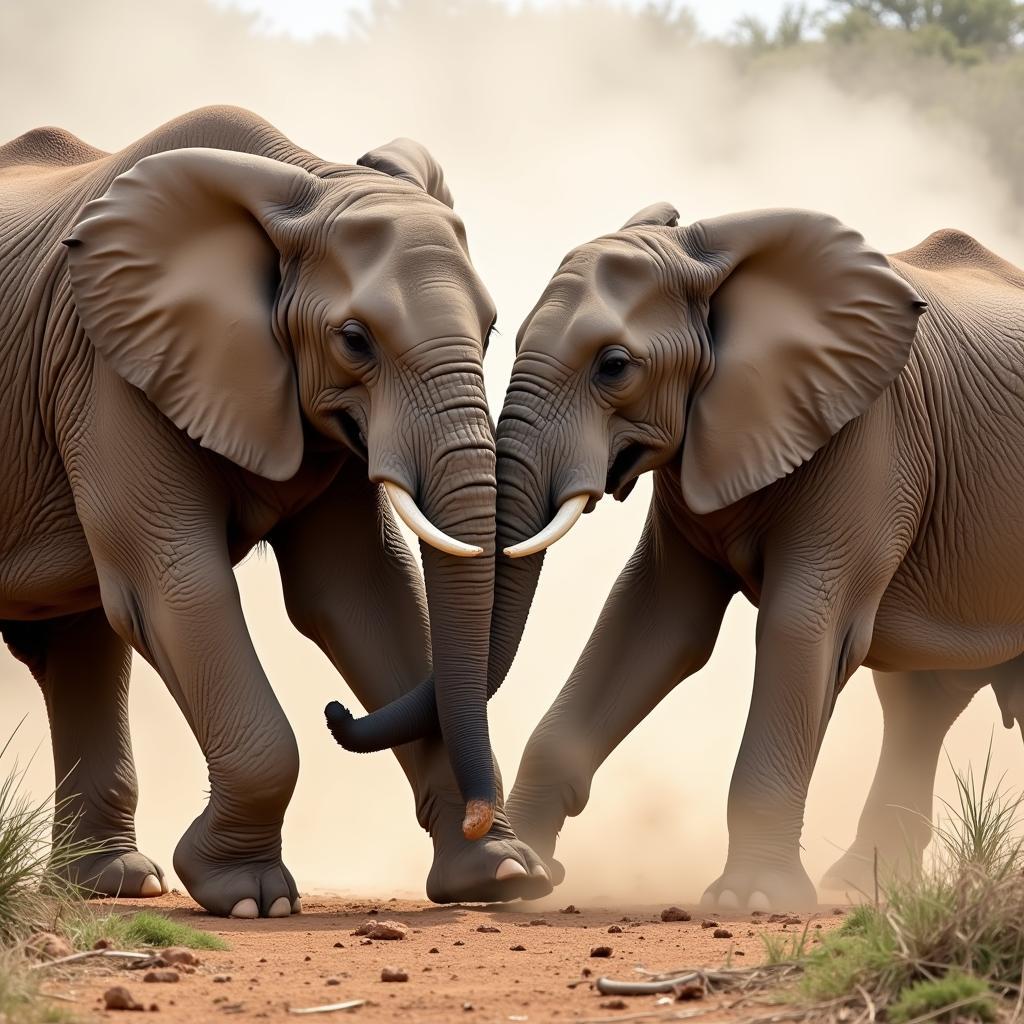The Thundering Clash: Understanding the African Elephant Fight
African Elephant Fights are dramatic displays of power and dominance, often leaving a lasting impression on those fortunate enough to witness them. These confrontations, though sometimes brutal, play a crucial role in maintaining the social order within elephant herds and ensuring the survival of the fittest. This article delves deep into the world of African elephant fights, exploring their causes, consequences, and the intricate social dynamics that underpin them.
Deciphering the Reasons Behind African Elephant Fights
Why do African elephants fight? Several factors contribute to these awe-inspiring clashes. Competition for resources, especially water and food during dry seasons, is a primary driver. Dominance displays between males vying for mating rights are also common, with older, more experienced bulls often challenging younger rivals. african elephant fights Hormonal surges during musth, a period of heightened aggression in male elephants, can further escalate conflicts. Even seemingly minor disagreements can quickly turn into full-blown fights, highlighting the complex interplay of factors influencing elephant behavior.
 Two African elephants fighting for dominance
Two African elephants fighting for dominance
The Anatomy of an African Elephant Fight
African elephant fights are rarely fatal, but they can be intensely physical. The elephants use their massive tusks, heads, and trunks as weapons, pushing, shoving, and sometimes even goring each other. The sheer force of these collisions is incredible, capable of breaking bones and causing serious injuries. However, most fights are ritualistic displays of strength, designed to intimidate rivals rather than inflict lethal harm. The fight often ends with one elephant submitting and retreating, allowing the victor to establish dominance.
How do elephants determine the winner?
The winner of an African elephant fight is usually determined by a combination of size, strength, experience, and aggression. Older, larger bulls with larger tusks often have an advantage, but younger elephants can sometimes prevail through sheer determination and aggression. The duration of the fight can also play a role, with the more persistent elephant often emerging victorious. The defeated elephant typically displays submissive behavior, such as lowering its head and retreating, signaling the end of the conflict.
The Social Implications of African Elephant Fights
African elephant fights play a vital role in shaping the social structure of elephant herds. They establish a clear hierarchy within the herd, with dominant males enjoying greater access to resources and mating opportunities. african elephanats iucn This hierarchical structure contributes to stability within the herd, reducing conflict and ensuring efficient resource allocation. These fights also contribute to the gene pool, as dominant males are more likely to pass on their genes to the next generation.
Dr. Amani Tembo, a renowned wildlife biologist specializing in African elephants, explains, “These fights, while seemingly violent, are an essential part of elephant society. They determine leadership and ensure that the strongest and most capable males have the opportunity to breed, contributing to the overall health and resilience of the population.”
Conservation Concerns and the Future of African Elephants
The future of African elephants is closely tied to conservation efforts. Poaching and habitat loss continue to pose significant threats to these magnificent creatures. Understanding elephant behavior, including their fighting patterns, is crucial for effective conservation strategies. african elephant current status By studying these intricate social dynamics, researchers can gain valuable insights into the needs and challenges facing elephant populations.
Professor Jabari Mwangi, a leading expert in elephant conservation, emphasizes, “Protecting elephants requires a deep understanding of their behavior and social interactions. Studying their fights can provide crucial information about their social structures, dominance hierarchies, and the impact of environmental factors on their behavior.”
Conclusion
African elephant fights are not merely displays of brute force; they are complex social interactions that shape the lives and future of these iconic animals. By understanding the reasons behind these fights, their social implications, and the conservation challenges facing elephants, we can work towards ensuring their survival for generations to come. Continued research and conservation efforts are vital to protecting these magnificent creatures and their crucial role in the African ecosystem. The ongoing struggle against poaching and habitat loss demands our attention and action. african elephant logo african elephant vs asian elephant fight
FAQ
- Are African elephant fights always fatal? No, most fights are ritualistic displays of dominance.
- What causes African elephants to fight? Competition for resources, mating rights, and hormonal surges.
- How do elephants determine the winner of a fight? Size, strength, experience, and persistence.
- What are the social implications of elephant fights? Establishment of dominance hierarchies and access to resources.
- Why is it important to study African elephant fights? To understand elephant behavior and develop effective conservation strategies.
- What are the main threats to African elephants? Poaching and habitat loss.
- How can we help protect African elephants? Support conservation organizations and raise awareness about the threats they face.
Need help? Contact us 24/7: Phone: +255768904061, Email: kaka.mag@gmail.com or visit us at Mbarali DC Mawindi, Kangaga, Tanzania.
